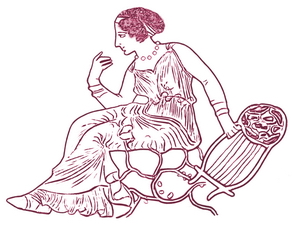Nētē
Nētē is the name of the highest note of the ancient Greek tonal system of two descending tetrachords which gave the birth to all European music. This system was directly derived from the strings and tuning of the lyre. The lyre had usually seven strings and used to be held during the performance similar way as today´s guitar. The string with the highest tension was the nearest to the ground and, at the same time, the most distant from the musician, the bass string with the lowest tension was the top one. Each string had its name resulting from this position, the most important being nētē [the lowest], mesē [the middle] and hypatē [the highest]. These strings formed a kind of frame of the oldest systēma teleion metabolon and their tuning was stable
concerning the intervals.
With almost holly respect and according to its position, each of the strings was connected with one planet from the beginnings of Greek music. The Greeks were open-minded observers and distinguished seven planets revolving around the Earth. Though Aristarchus of Samos created the first heliocentric model of the universe in the 3rd century BC, it was never taken seriously and the only alternative was the geocentric model. This was shielded by the authority of Aristotle and nobody dared to doubt it until the times of Nicolaus Copernicus. Therefore, the Moon and the Sun were te planets too, fulfilling the meaning of the Greek expression astēr planētēs [wandering star], and their courses, together with the course of Saturn, were taken for stable. The courses of the remaining planets were unstable which found a symbolic counterpart in the unstable interval tuning of the appropriate strings, making use of quarter tones. This is the beginning of the well known "music of the spheres" which was discoursed, for instance, even by Johannes Kepler in his book Harmonices Mundi from 1619. According to this theory, each of the planets emits a tone depending on its weight, velocity and position towards the Earth
and the other planets as well.
"Now from the course of Saturn, which is highest in relation to us, the deepest note in the octave was named hypatē [uppermost], for what is highest is uppermost. From that of the Moon, which is furthest down of all and circles the Earth most closely, there was taken the name neatē [lowest]: for what is furthest down is lowest. From the course of those which are next to [para] each of these is named on the one hand parhypatē (form the one below Saturn, which is that of Jupiter, and on the other paraneatē (from the one above the Moon, which is that of Venus). From the one which is in the middle, that of the Sun, which lies fourth in order from each end, there is named mesē [middle], which is set - at least according to the ancient practise, within the heptachord - at the interval of a fourth from both extremes, just as the Sun also is fourth from each end among the seven planets, an lies in the middle. As to those on each side of the Sun, from the course of Mars, which has been alloted the sphere between the Sun and Jupiter, there is named hypemesē [above mesē], which is also known as lichanos; and from that of Mercury, which holds the region between the Sun and Venus,
there is named paramesē [beside mesē]."
Nicomachus of Gerasa, Handbook of Harmony 3, 241 - 242
Saturn · hypatē · e
Jupiter · parhypatē · f
Mars · hypermesē · g
Sun · mesē · a
Mercury · paramesē · bb
Venus · paranētē · c′
Moon · nētē · d′
It is possible to find no less beautiful variation on this theme in ancient Delphi. Here, in the famous temple of Apollo, three Muses of lyre were worshipped under the names
Nētē, Mesē and Hypatē.
In our times we still know the names of the nine Muses. But it is not commonly known that originally there were only three of them and their names were Meletē [Practice], Mnēmē [Memory] and Aoedē [Song] (Pausanias, Description of Greece IX 29). These are sometimes called "the generation of Muses before Hesiod". The equivalents of these three were Nētē, Mesē and Hypatē but it was so only in Delphi. It is important to be said that Apollo was not only the god of light and sun and the originator of beauty, art and harmony, but he was also the patron of plucked instruments. On the contrary, wind instruments belonged to the cult of Pan.
The only ancient writer mentioning Nētē, Mesē and Hypatē as the Muses is Plutarch of Chaeronea. He is the only one but fully reliable source. Not only because he was highly educated and respected but mainly because of the fact that for more than twenty years he served as one of the two priests in the Temple and was responsible for interpreting
the predictions of the oracle.
Plutarch states that "the Delphians...affirm that the Muses amongst them were not named so either from the strings or sounds in music; but the universe being divided into three parts, the first portion was of the fixed stars, the second of the planets, the third of those things that are under the concave of the moon; and all these are ordered according to harmonical proportions, and of each portion a Muse takes care; Hypatē of the first, Nētē of the last, and Mesē in the middle, combining as much as possible, and turning about mortal things with the gods and earthly with heavenly".
(Plutarch, Symposiacs IX 14)

